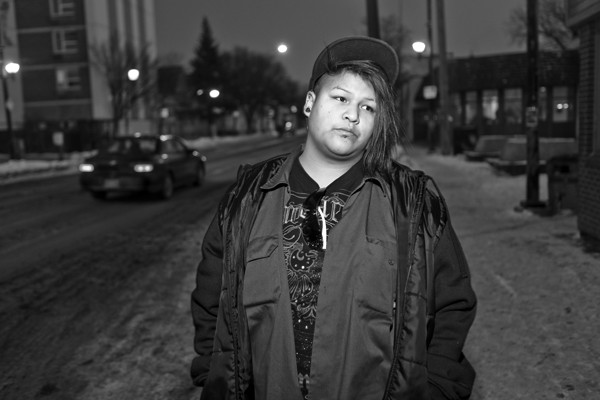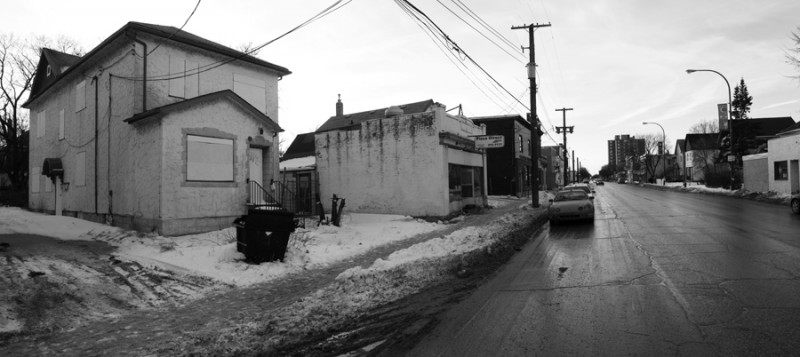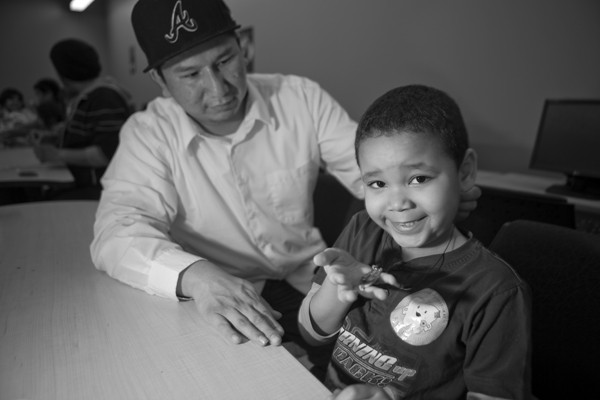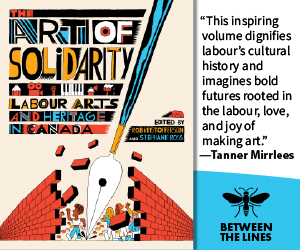“If you want to change violence in the ‘hood, you have to change the ‘hood”
Violence and street gangs in Winnipeg’s inner city

Jenna Wirch, a 17-year-old participant at the Ndinawe Resource Centre on Selkirk Avenue says that may obstacles are placed in young peoples’ way simply from appearing to be “gangster.” Although growing up in the North End, Jenna has never been in a gang and dreams to become a lawyer and a politician to help make positive change for her people. Photo by Scott Stephens.
In the summer of 2009, at a funeral in Winnipeg’s North End following a gang-related drive-by shooting, two of us were approached by members of a North End street gang. They wanted to talk. They approached us because we have all worked for many years in Winnipeg’s inner city, and they felt they could trust us. The four of us met with six Aboriginal street gang members – all of whom have served time in prison and have spent much of their lives in street gangs – over two days in a location outside of Winnipeg.
Too often the voices of the people who have intimate knowledge of, and are integral to, the problems in Winnipeg’s inner city are not heard. Our report, the following of which is an extract, endeavours to give a voice to these six Aboriginal men.
Boarded up home on Selkirk Avenue, Winnipeg. Once a bustling commercial strip, the street suffers from lack of investment which has wider impacts on the local community. Photo by Scott Stephens.
“Getting tough on crime”
These gang members accept that committing crime means doing the time. “I’m a gang member,” one said. “I do what I do. I am what I am. There has to be laws for people like me.” But they are emphatic that prison will not solve the violence in the inner city.
None like prison. But doing time is a badge of achievement in street gang circles. Besides, prison also “teaches you street smarts” and “turns you into a better criminal.”
One man told us that he “grew up in prison.” To survive, he had to be prepared to use violence. He did. Another described the irony: “They put us in a society [prison] where violence is prevalent and tell us not to be violent.”
Ex-gang member and now youth mentor Kevin Abraham believes that the drum, traditional teachings, and re-learning the culture are the keys to true gang prevention. Kevin does a lot of gang prevention work beyond his role as a youth mentor. Photo by Scott Stephens.
Any short-term solutions out there?
Last summer, 2009, in response to the growing levels of gang-related violence, the Winnipeg Police Service flooded the North End with officers, to the point where “it’s like the military in the North End now.” Everyone who “fits the description” – young, male, Aboriginal – is targeted. Policing is aggressive, sometimes violent, and often accompanied by racist epithets.
This crime control strategy, according to the men, only angers those who are targeted merely because they “fit the description.” As for street gangs: “All you’re gonna do is slow us down a little bit. And the next day someone else gets out [of prison] and the same shit starts again.”
Guns are now prominent in Winnipeg’s inner city, to the point where “buying a gun these days is almost easier than buying a gram.” Street gangs use guns because the trade in illegal drugs is a “dog eat dog” business that’s “all about money,” and “you can’t be seen to be weak.” In this environment, we were told, a gun amnesty would fail.
What about a truce among the street gangs? “Not for a second!” Street gang leaders know each other and talk on occasion: “We’ve all gone to prison together since we were little kids.” But there is no trust. “There’s too much bad blood.” More importantly, even if a truce was agreed to by the main gangs, there are now too many smaller gangs that would not feel bound by it.
One of the components of the province’s new “anti-gang strategy” is to replicate the Winnipeg Auto Theft Suppression Strategy (WATTS), which involves intensive monitoring of the highest risk auto thieves. Some fifty known gang members are now being targeted under this crime control strategy. The men saw this not only as a band-aid solution, but one created for a different problem. “You can’t take this band-aid off and put it on that wound.”
These men were adamant that there are no meaningful short-term solutions. “You can’t take an aspirin for the North End and it’ll be over in half an hour.”
Roots of street gang violence
Street gangs grow from poverty and systemic racism, with all their familiar consequences: addictions, family disintegration, childhood neglect, abuse. These are the result of historical social forces – deindustrialization, divestment, the abandonment by the state of low-income urban spaces, colonization – that are largely beyond the control of individuals living in the inner city.
A discarded newspaper on Selkirk Avenue opened at a tragic article of a young Aboriginal artist dying from violence. Although not gang related, the story reveals the depth of the problems facing Aboriginal youth and community. Violent crimes are three times higher among Aboriginal people. Photo by Scott Stephens.
Hunger was also normal. One described breaking into a storage building with other kids and stealing potato chips when there was no food at home.
But doesn’t the fault lie with the parents? The men’s reply was typically hard-headed. Yes, there’s lots of bad parenting, but that too is a product of poverty and colonization. Simply saying parents should do better is no solution. For them, that is the way it was, that was their world.
That world hasn’t changed. One told us, “Go to the North End at 1:00 a.m. or 2:00 a.m. tonight. You’ll see eight and ten year olds running around unsupervised.”
“That’s the next me,” he said. “That’s the next brother.”
“Those are the ones you have to help to slow the violence,” we were told. “You need to help those little kids get off the street.”
One described recently being in a North End store. Two small kids were there, dirty and poorly dressed. They were trying to scrape together change to share a sandwich. He gave them twenty dollars. Why? “Because that was me. I was that dirty Indian kid. I didn’t have nothin’. I had to steal it.” Unfortunately, the kids then say to each other: “Did you see that guy’s wad of cash?” And the cycle continues.
Getting tough on poverty
We take seriously the phrase oft-repeated over our two days of conversations: “If you want to change the violence in the ‘hood, you have to change the ‘hood.” Anything less is not “tough” enough. Anything less perpetuates the cycle that produces street gangsters, and the violence that is an inevitable aspect of the gangster lifestyle. Anything less than an attack on poverty and systemic racism is actually being “soft” on crime.
These men deeply resent the lack of resources in the North End. “If you look at the city of Winnipeg, where’s the biggest problems? In the north side. What’s in the north side? Nothing.”
Blake Constant shows off his new necklace, made with the help of youth mentor Kevin Abraham. Positive role models like Kevin are essential for helping these young kids avoid gangs as they get older. Photo by Scott Stephens.
So, what can be done?
Let’s start by investing in jobs. Many street gang members want to work, but simply cannot walk into a mainstream job. Their physical appearance, demeanour, and rough language just wouldn’t fit. But they will take up legitimate work when the right kinds of jobs are made available. Putting street gang members to work benefits not only them but also “the young ones ‘cause they’re seeing it. And it’s going to benefit the community because then they’re bringing their pride to themselves.”
We can do this by creating jobs to fit them and their reality. We know this will work because there are successful, small-scale examples – such as Ogijita Pimatiswin Kinamatwin (OPK), Inner City Renovations, and BUILD – now operating in Winnipeg’s North End. The Province of Manitoba invested its fiscal stimulus package this past summer in renovating every unit in some North End public housing projects, and to their credit they used a “hire locally” strategy. There has been no shortage of local young people anxious and able to do this work.
The lesson to be drawn is that if the right jobs are created, young inner city people will work. And as they take on legitimate jobs, their extended families and communities will gradually be strengthened. More youngsters like the kids in the store will see that there are ways to live dignified lives not ground down by poverty. The soil in which street gangs inevitably grow will become less fertile.
The wisdom of street gangsters
We should continue to send violent offenders to prison. But we shouldn’t fool ourselves into thinking that this will solve North End problems. Filling our prisons with more young Aboriginal men – over seventy percent of inmates in Manitoba are Aboriginal – will not stop the violence.
These street gang members bring the wisdom of experience that has been missing in the public debate about inner city violence. They are part of the problem. They know that. But they can be part of the solution if we collectively have the courage to go down a different road, and create real opportunities for them.
If, on the other hand, we continue in simplistic fashion to blame them and their families, and to throw even more of them in jail and prison, the problem will only worsen.
We believe these street gang members have it right: if you want to change violence in ‘hood, you have to change the ‘hood.
This article appeared in the March/April 2010 issue of Canadian Dimension (Indian Country).









.v1_600_400_90_s_c1.jpg)
